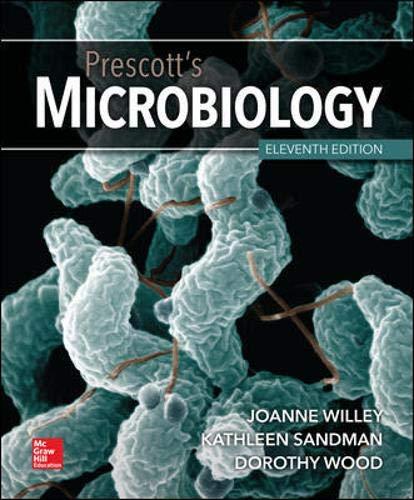
Prescott's Microbiology
11th Edition
ISBN: 9781260211887
Author: WILLEY, Sandman, Wood
Publisher: McGraw Hill
expand_more
expand_more
format_list_bulleted
Concept explainers
Question
Chapter 23.1, Problem 2.3CC
Summary Introduction
There are about 150 species under the genus of Streptomyces. It is a large genus. All of them are obligate aerobes. The bacteria that belong to this family and the similar ones are termed as Streptomycetes. This term is derived from a Greek word Streptos meaning bent; myces means
Expert Solution & Answer
Want to see the full answer?
Check out a sample textbook solution
Students have asked these similar questions
List the major physiological properties of the genus Bacteroides.
Give two commercial identification systems for enterobacteriaceae aside from the API 20E.
Examine the graph shown below of a liquid culture growth curve for S. pneumoniaegrowing in minimal broth containing both glucose and lactose in equal concentrations as a potential carbon source. Answer the following questions:
a) Name the growth phases labelled as I, II and III, explain the observed pattern of growth at each of these stages in the curve
b) Where would the concentration of cAMP be low and why?
c) In what phase would β-galactosidase be high and why?
d) What kind of overall growth pattern does this curve illustrate?
Chapter 23 Solutions
Prescott's Microbiology
Ch. 23.1 - MICRO INQUIRY Refer to table 24.2 and determine...Ch. 23.1 - MICRO INQUIRY Why do Mycobacterium spp. have...Ch. 23.1 - Prob. 3MICh. 23.1 - Prob. 1.1CCCh. 23.1 - Prob. 1.2CCCh. 23.1 - Retrieve, Infer, Apply Why are actinobacteria of...Ch. 23.1 - Prob. 1.4CCCh. 23.1 - Retrieve, Infer, Apply Compare the morphology and...Ch. 23.1 - Prob. 1.6CCCh. 23.1 - Prob. 1.7CC
Ch. 23.1 - Prob. 1.8CCCh. 23.1 - Retrieve, Infer, Apply List the distinguishing...Ch. 23.1 - Prob. 2.2CCCh. 23.1 - Prob. 2.3CCCh. 23.1 - Retrieve, Infer, Apply Describe three ways in...Ch. 23.1 - Briefly describe the defining properties of genera...Ch. 23.1 - Prob. 2.6CCCh. 23.1 - Examine the ingredients list on a commercial...Ch. 23.2 - What growth or survival advantage might this type...Ch. 23.2 - What is the net yield of ATP for each glucose that...Ch. 23.2 - Prob. 3MICh. 23.2 - Prob. 1CCCh. 23.2 - Prob. 2CCCh. 23.2 - Prob. 3CCCh. 23.2 - Prob. 4CCCh. 23.2 - How are various species of Streptococcus...Ch. 23.2 - Of what practical importance are leuconostocs?...Ch. 23.2 - What is the difference between -hemolysis and...Ch. 23.3 - The presence of an electron transport chain in a...Ch. 23.3 - In addition to its Gram-staining characteristics,...Ch. 23.3 - What are the two sources of electrons for the H....Ch. 23.4 - Prob. 1CCCh. 23.4 - Suggest why C. tetani uses a sodium motive force...Ch. 23.4 - Prob. 3CCCh. 23.4 - What kind of genetic evidence, in addition to 16S...Ch. 23 - Prob. 1RCCh. 23 - Prob. 2RCCh. 23 - Prob. 3RCCh. 23 - Prob. 4RCCh. 23 - Prob. 5RCCh. 23 - Prob. 6RCCh. 23 - Prob. 7RCCh. 23 - Prob. 8RCCh. 23 - Prob. 9RCCh. 23 - Prob. 10RCCh. 23 - Even though actinobacteria are high G + C...Ch. 23 - Given that mycolic acids are essential for...Ch. 23 - Prob. 3ALCh. 23 - Prob. 4ALCh. 23 - Prob. 5ALCh. 23 - What physiological properties might account for...Ch. 23 - S. aureus strains that are resistant to...Ch. 23 - Prob. 8AL
Knowledge Booster
Learn more about
Need a deep-dive on the concept behind this application? Look no further. Learn more about this topic, biology and related others by exploring similar questions and additional content below.Similar questions
- Write a paragraph describing the colonies of: A) Clostridium perfringes B) Clostridium tetani C) Clostridium botulinumarrow_forwardHow can you use the unique characteristics to produce a growth medium that is both selective and differential that can aid in the isolation of Listeria monocytogenes?arrow_forwardBrocadia anammoxidans is required to rid of ammonia from sewer water in the treatment method, one of its main biotechnological uses. Hence, these are related to some denitrifying bacteria. What are other denitrifying bacteria that are related to this?arrow_forward
- How was the product of streptomycin isolated by the scientist who discovered this?arrow_forwardBriefly describe the mechanism by which endospores of Clostridium difficile may cause the disease pseudomembranous colitis in humanarrow_forwardWhat are the essential environmental requirements for cultivatingCampylobacter?arrow_forward
- Why is the mold Penicillium economically important?arrow_forwardhow can you use the unique characteristics of Listeria monocytogenes to produce a growth medium that is both selective and differential?arrow_forwardi)What are phytoalexins? ii)Explain how it is synthesized? iii)Briefly, explain a few distinctly different approaches to mass producing phytoalexins for medicinal use.arrow_forward
- How does the physiology of C. perfringens make it suitable forgrowing in puncture wounds?arrow_forwardWhat are the conditions necessary for fixation of atmospheric nitrogen byRhizobium. What is their role in N2-fixation?arrow_forwardWrite a paragraph describing the microscopic morphology of: a) Clostridium perfringes b) Clostridium tetani C) Clostridium botulinumarrow_forward
arrow_back_ios
SEE MORE QUESTIONS
arrow_forward_ios
Recommended textbooks for you

Industrial Processes and By-products | 9-1 GCSE Chemistry | OCR, AQA, Edexcel; Author: SnapRevise;https://www.youtube.com/watch?v=CMLKgqEMXwc;License: Standard Youtube License